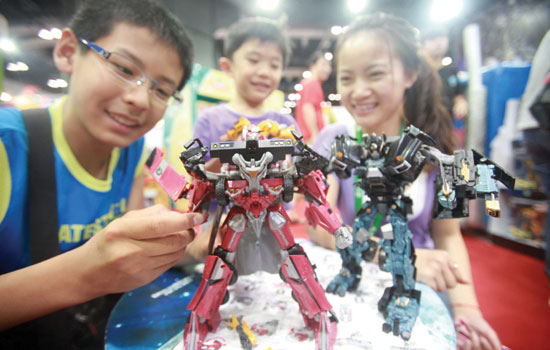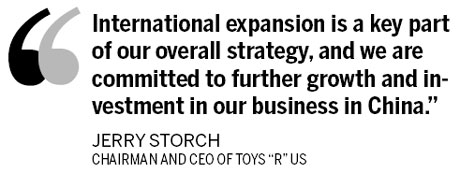|
 |
|
Children play with Transformers at a toy exhibition in Beijing. Chinese toy market is expected to double to 60 billion yuan ($9.63 billion) by 2015 from 2010. [Photo/China Daily] |
Companies eye rich pickings from nation's 400 million youngsters
For Wang Ye, a 33-year-old housewife in Beijing, it's difficult to understand how a simple toy truck can distract her 15-month-old son for hours at a time.

Wang, who said she had more experience with books than with toys as a child, takes her son to the Joy City Shopping Mall in the capital's Xidan neighborhood about three times a week. She said her son is able to sit in a toy store for more than an hour without wanting his mother.
That worries her. What if he becomes addicted to toys? What if he keeps asking for more and more toy trucks?
"The daughter of my cousin is about 4 years old now, and no matter how many toys her mother buys, she still asks for new ones," Wang said.
Wang is among China's latest generation of new parents in their late 20s and early 30s who are stuck in a parental conundrum. Many of their own parents preached education over playtime, and hard work over leisure.
But after three decades under the one-child policy in China and rapid economic growth, in which more affluent families are focusing all their attention on their babies- and with new parents often believing the easiest way to take care of their elderly parents is by living with them - there are plenty of adults looking after and spending on the only child in the apartment. The opportunities for the toy industry are obviously plentiful.
"Nowadays, kids are very lucky to have so many fancy places to be and so many options to play with," Wang said.
But in order to get more parents and grandparents to frequent toy stores, companies are hoping that recreation is seen as a more important part of child rearing. So what should a toy company in China do to be more successful, especially in a country where the average annual spending on toys per child, rural or urban, in China is less than 30 yuan ($4.80). The figure ranks far behind the Asian average of $13 per year.
Fortunately, there are more than 400 million Chinese children aged 14 or younger. China also manufactures more than 70 percent of the toys in the world, and its toy market is expected to double to 60 billion yuan by 2015 from 2010, according to the China Toy and Juvenile Product Association.
One resource that companies can use to find clues as to what strategy reaps success in China's toy industry is the shopping mall, according to industry experts. Many major toy companies, such as Walt Disney Co, Lego, Toys "R" Us, and Mattel Inc, have expanded their sales coverage in China within the past three years.
At the Joy City Shopping Mall in Beijing which Wang frequents, there are around 20 stores catering to children, including a 1,300-square-meter Toys "R" Us.
Stores for children, experts say, are highly welcomed by commercial real estate companies in China. In a shopping mall, these toy stores can attract more customers and at the same time enhance the mall's retail, dining and entertainment sales figures, according to Joy City Shopping Mall representatives.
"Opening up in shopping malls is definitely the strategy that Toys "R" Us is adopting in China. Chinese consumers prefer places where there is a lot of entertainment, which is different from most of our traditional markets," said Mark Murphy, country manager for Toys "R" Us China. "We try to make our stores more enjoyable to be in."
The Joy City Shopping Mall store is the company's model for further expansion in northern China in terms of size, layout and location, Murphy said.
